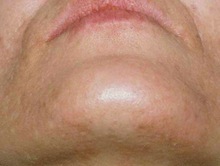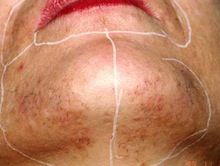Face off
Facial hair can be a sensitive subject for women. Suzanne Braithwaite explores the options from waxing to laser and IPL
While they may not openly discuss it, many women spend years battling with unwanted hair on the face. In fact, facial hair was named the biggest fear in a recent study into the hair removal habits of 3,000 British women, by shaving company Remington. On average, women spend £8,000 on hair removal during their lives and would be prepared to spend £712 to permanently remove unwanted hair, the study found.
So with many potential clients willing to part with their cash to find a lasting solution to facial hair, the market for salons is considerable, but can also be confusing. Factors such as the client’s skin and hair type, any underlying hormonal issues as well as embarrassment surrounding the subject all play a key part in choosing the right hair removal option.
Waxing, threading, electrolysis, IPL or laser can all be used to treat unwanted facial hair. Clients often consider waxing to be the cheaper route, but this involves treating hair every four to six weeks for the rest of the client’s life.
“In one year of waxing (on a facial area) a client would spend the same amount of money as a full course of IPL, which could last up to five years,” suggests Chloe Scriminger, company trainer for London specialist hair removal salon Ministry of Waxing.
Though machine-based hair?removal can prove more profitable?in the long run for both salons and?clients, waxing is still the bread and?butter of many businesses and has?dramatically evolved over the last decade. Wax?specialist Kim Lawless, who trains for Perron Rigot, says, “Back when a good wax was more difficult to come by, it was common to see breakouts after facial waxing because the products were too harsh, but now waxes, including Perron Rigot’s Visage wax, use ingredients that soothe the skin. And the temperature is much cooler, so is more comfortable.”
Sensitive skin
When waxing facial hair you need to consider the hair type, as coarse hair requires a different wax to downy hair. It’s also important to consider that facial hair in women may be caused by an underlying hormonal issue such as polycystic ovary syndrome (PCOS).
“Women with PCOS can sometimes have excess facial hair, which can be coarse. This is exacerbated by continual, often daily, tweezing, which makes the hair stronger and more stubbly,” says Lawless. “Waxes such as Visage can remove the hair from the root, even when it is very short. If done at regular intervals, without tweezing in between, the client will find they can leave longer and longer between waxing.”
Ellen Kavanagh, creator and director of Irish waxing brand Waxperts, advises a thorough consultation when treating a client for facial waxing, especially if they suffer from PCOS, because they may have started medication that alters their skin or be using a new face product that could thin their skin, leaving it more prone to injury. “If when you remove wax from the face the skin underneath is shiny and the back of your hot wax patch has an opaque look to it, you have removed the skin,” she says. “It only takes a few moments to double check these things and it’ll give you and your client peace of mind.”
Wax on, wax off
Kirstie Sherriff, director of Pinks Boutique, agrees that facial hair requires more care. “The therapist has to be skilled, as it’s much more noticeable if you miss hairs on the face,” she says. “The potential to damage the skin is also vastly increased when you are working around the eye and lip area, so think carefully about the products you use.” She suggests using an organic pre-wax cleanser because many non-organic options have “a very high alcohol content which strips the skin of its natural moisture balance”
Andy Rouillard, owner and manager of specialist wax salon Axiom Bodyworks, suggests the best method for facial waxing is peelable wax. “You can apply it much thinner than other waxes and in the direction of hair which saves money as less is used,” he says. “It is more flexible as the formula is made up of polymers and used at a lower temperature. It can be used on facial areas as well as intimate areas. Brands such as Outback Organics, Adam and Eve, and Hive of Beauty, among others, all offer a peelable wax.” Peelable wax can also be used on brittle hair as it is removed gently, which also makes it better for clients with a low pain threshold.
Hair today, gone tomorrow
While waxing brands are trying to come up with more efficient and less painful ways of waxing, more clients are now thinking about longer lasting solutions to hair removal. IPL and laser are considered powerful options for long-term reduction of unwanted facial hair.
It is commonly understood that IPL and laser hair removal works best when the hair is darker than the skin. Dr Samantha Hills, who advocates machines from Lynton Lasers, says, “The treatment is most effective when the hair follicle reaches a temperature high enough to destroy the follicle while the epidermis remains below the damage threshold temperature.”
However, manufacturers such as Lynton are coming up with new ways to combine laser wavelengths to treat fine hair, which is often found on the face. For example, Lynton’s Duetto MT (Mixed Technology) simultaneously delivers a mixture of both Alexandrite (755 nm), which is used for hair removal in patients with Fitzpatrick skin types I to IV, and the Nd:YAG (1064 nm), which is usually used on clients with darker skins of Fitzpatrick type V and VI. “Mixed Technology mode enables safer and more effective treatments on fine hair on darker and tanned skins,” explains Hills.
Hair maintenance
When it comes to treating PCOS suffers, it is important to be mindful of dormant hair follicles. Callie Woodward, trainer at Ellipse and Venus System UK, explains, “With hair removal treatment, our main aim is to catch the hair in the growing stage. However, many different factors influence growth, such as age, ethnicity, medication, hormone levels and body size.”
While most PCOS suffers respond well to treatment, light treatment can cause “paradoxical” hair growth, explains Dr Maria Gonzalez, a dermatologist who conducted a study into IPL hair removal at the University of Wales: “This is where light stimulates dormant hair follicles to move into the active growth phase, though this usually happens when insufficient energy is used.”
However, as the new hair moves into the active phase it can then be treated successfully. “It is important to explain to PCOS sufferers that IPL can offer hair growth management rather than complete clearance because hair growth can keep coming back,” she advises.
Man factor
It is not just women who want permanent hair removal. A survey by laser manufacturer Syneron Candela revealed that 33% of men would now consider permanent removal as a solution to unwanted hair. Eddie Campbell-Adams, global marketing manager for Energist, has noticed the lower beard area is a very popular zone for facial hair removal in men now because, as well as tidying the area, it reduces irritation from shaving rash and ingrown hairs.
“On the facial area it is important to have a laser or IPL system that is powerful enough to give great results on hormonally induced hair growth and finer hair found on the sides of the face, but also safe enough not to cause side effects,” he adds.
Before and after Energist IPL treatment on the skin:



